Aventon Soltera 2.5 Review | Precise Handling; Lightweight Feel
For a budget-priced bike, it doesn’t feel cheap in the slightest. Aventon’s city bike has a terrific feel on the road, and its lightweight design is easy to manage when out of the saddle.

In my early e-bike days, I was drawn to the powerhouses of the e-bike world. But with each passing year, I’ve gained a deeper appreciation for lighter, more efficient rides that prioritize precise handling and a natural (yet still powerful) feel. If that sounds like your jam, let me tell you about the Aventon Soltera 2.5, which our team has spent several weeks testing.
This bike pulls off a lot for its price point. Bikes in the $1,000–$1,200 range, like the Soltera, are clearly designed to be value plays, but the Soltera doesn’t feel like a “budget” e-bike at all. Its motor has excellent engagement, syncing seamlessly with your pedal effort. While the motor power is admittedly more modest than some other e-bikes, that’s by design. This bike will boost your speed and take the edge off hills, but it still feels like you’re doing the riding—not just along for the ride.
The Soltera’s handling is arguably its standout feature. The stiff frame and narrow tires make it feel quick and agile on the road. It corners confidently, and with upgraded, more powerful brakes, it can stop on a dime when needed.
Aventon is one of the few e-bike brands that makes its own frames, and it shows. The clean lines, refined angles, and thoughtful cable management give the Soltera some serious aesthetic appeal that others lack at this price. The frame also feels well-balanced, something I didn’t expect with its shorter-than-average top tube. Ultimately, the overall design delivers a bike that’s not only fun to ride but also comfortable by city bike standards.
That said, there are a few limitations to note. The Soltera 2.5 comes in three frame sizes to help riders find their fit, but there’s no mid-step option, meaning it’s better suited for taller riders. You might also want to budget for a few add-ons to maximize its potential as a city commuter. Even so, this bike nails what most people want in a lightweight option: a natural, responsive ride with solid power—and one that won’t make you dread hauling it up a flight of stairs with a manageable amount of weight.
To dive into all the details and see how it performed in our testing, keep reading the full Soltera 2.5 review below.
Class 2 (throttle to 20 mph)
 Pros
Pros- Responsive handling. The bike’s narrow, efficient tires, compact handlebars, and rigid front fork make maneuvering feel precise and sharp.
- Great motor engagement. The motor delivers noticeable power, helping you ride faster, but its delivery feels smooth and natural—like a faster, enhanced version of yourself.
- Lightweight. Weighing only 46 lbs., this bike is a featherweight compared to most e-bikes. It’s easy to move around when you’re off the saddle and feels closer to a traditional bike on the road.
- Comfortable geometry. With a shorter top tube, a relaxed reach, and handlebars with rise and sweep, the bike provides a more upright and relaxed riding position than many others in this category.
- Three frame sizes are available. For an entry-level price, offering three frame sizes is a standout feature compared to the usual one or two size options, making it easier to find a good fit.
- Clean aesthetic. The frame features sleek lines, well-managed cables, and a sharp-looking color display. It’s a bike that balances functionality with visual appeal.
- Practical accessories. Aventon keeps the base price low by not including too many accessories, but everything you need to transform this into a full-fledged city commuter (like fenders and racks) is available at checkout.
- A great app. Aventon’s app offers practical features like ride customization, gamified medals to encourage more cycling, community engagement, and trip-planning tools.
- Solid safety features. The integrated rear lights, turn signals, and hydraulic brakes enhance safety for urban riding.
 Cons
Cons- The new hydraulic brakes are a welcome upgrade over the previous 2.0 model. However, the new setup no longer supports brake light functionality.
- The high-step frame feels great, but it looks like there is no longer a mid-step option as we’ve seen in previous generations. The ride will be better suited for riders with at least a 30” inseam.
- Battery: Removable Internal Lithium-ion 36V,9.6Ah(345.6Wh) with LG Cells
- Display: Aventon BC280, color display, USB-A port
- Motor: 36V, 350W brushless hub motor, 45Nm torque
- Charger: 36V, 2 amp fast charger
- Headlight: Included
- Taillights:Integrated, brakes and turn signal lights
- Pedal Assist: 4-levels, torque sensor
- Claimed Range: 46 miles
- Tested Range:
- Throttle:included, thumb lever
- App:Aventon
- UL UL 2274 certified, TUV Rheinland Certified in accordance with UL 2849
- Claimed weight: 46 lbs
- Tested Weight: 45.6 lbs with battery
- Rider height range: 5’1” -6’2”
- Total payload capacity: 300 lbs
- Brakes:Tektro HD-T280 Hydraulic disc brake w/o e-cutoff
- Fenders:N/A
- Fork:AE-E09 Soltera AL fork
- Frame: 6061 Double-Butted Aluminum Alloy with Internal Battery
- Drivetrain: Shimano Tourney RD-TY300D 7 speed, Revoshift, 48t chainring, 14-28T freewheel
- Grips: Lock on grips with twist shift
- Saddle: Aventon custom
- Handlebar: Aluminum 31.8mm, 620mm
- Kickstand: Included
- Pedals: 9/16″ Alloy Platform
- Tires: Kenda K1085 700x38C
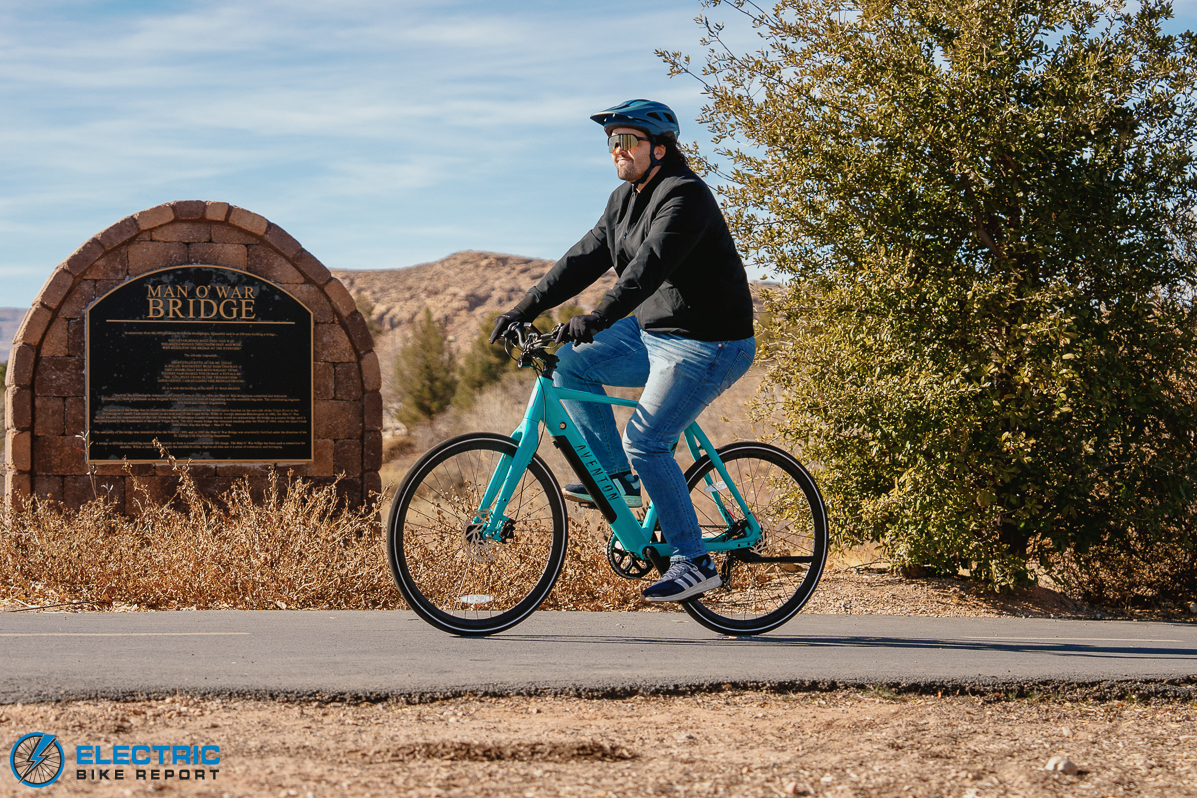
The Soltera 2.5 moves and feels a lot like an analog bike.
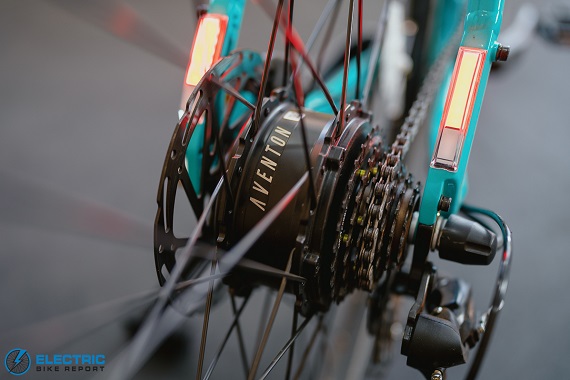
The 350W motor is discreet, but it provides meaningful power to your ride.
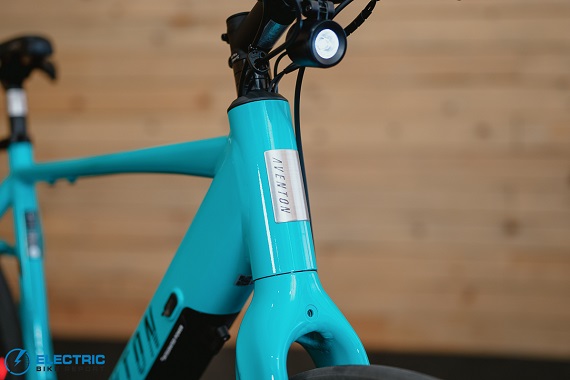
One of the improvements was cable routing. It now runs down into the headset instead of through the downtube, making the front of the bike look cleaner.
Aventon Soltera 2.5 Review: Speed Test

The Soltera 2.5 offers a well-balanced speed distribution, and during testing, I came to really appreciate the bike’s efficient design.
Each point on the line graph above represents the speed I was able to hit with casual pedal effort. Thanks to the bike’s lightweight frame, even a modest motor goes a long way. Hitting 20 mph isn’t actually difficult in any assist level if you put in the effort—it just becomes progressively easier as you climb through the assist modes.
The bike’s torque sensor does an excellent job of syncing with your pedal input and the drivetrain. When you push harder, the motor rewards you with more power. When you ease up, the motor does the same. This creates a natural, intuitive riding experience that almost makes you forget you’re on an e-bike—except for the faint motor whine you might notice at higher speeds.
I also appreciated the Soltera’s shifter. The Revoshift provides a satisfying click with each gear change, and the overall gear range feels well-suited to a bike designed for Class 2 speeds.
Would Class 3 speed capabilities have been nice? Sure. But that might have stretched the limits of the drivetrain and invited ghost pedaling into the equation. As it stands, 20 mph on flat ground feels more than adequate, and the bike’s fast-rolling tires allow it to really pick up speed when cruising downhill.
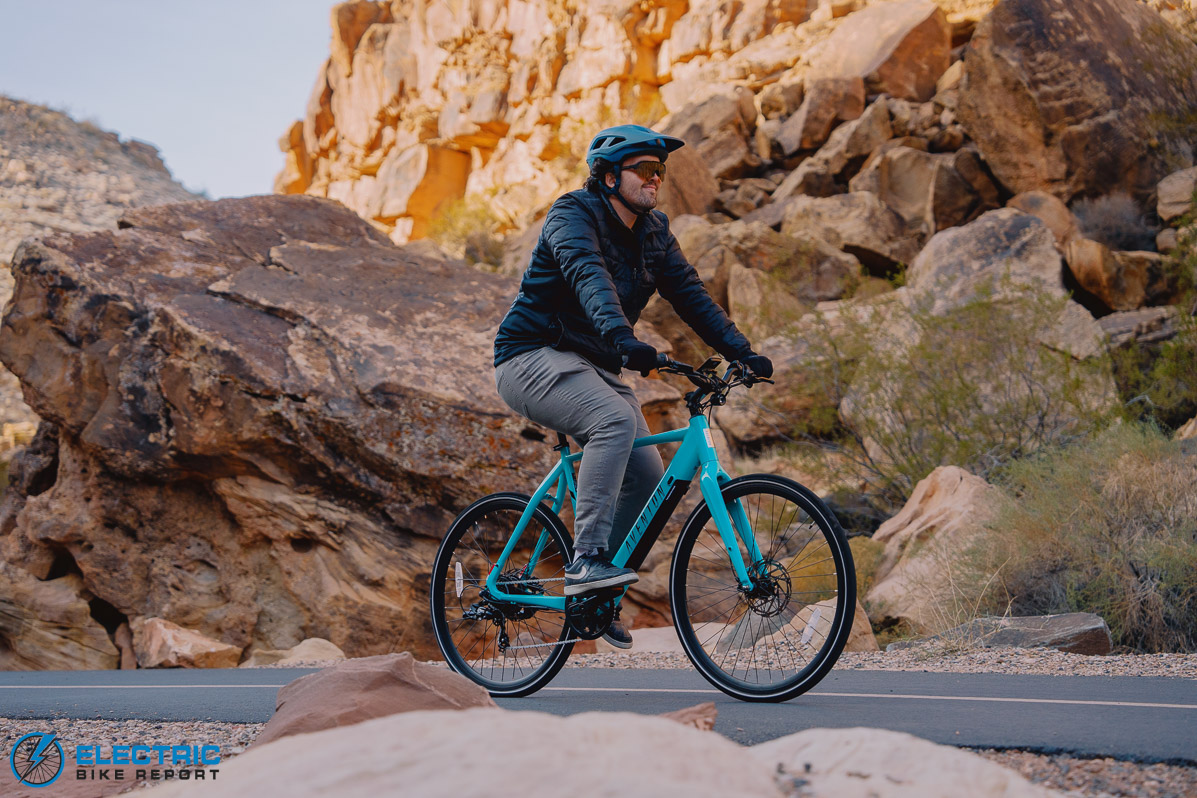
The light frame and narrow tires roll really well. It doesn’t take a huge effort to get up to speed.

The drivetrain is the entry-level Tourney derailleur and 7-speed cassette.
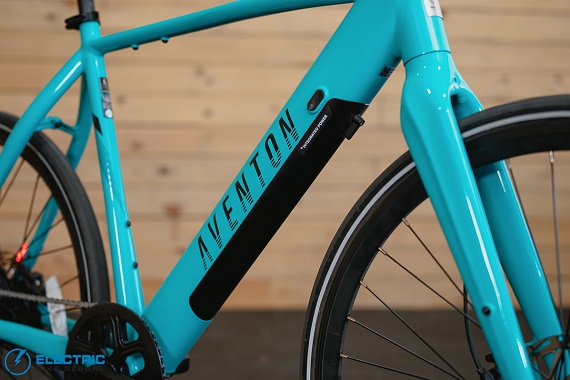
The battery can be removed for charging off the bike.
Aventon Soltera 2.5 Review: Range Test

The battery life on the Soltera 2.5 proved to be excellent. In our Max Power Range Test, we managed to cover 29.26 miles, and in our Min Power Range Test, using only Eco assist, we hit an impressive 55 miles. Aventon advertises a range of “up to 46 miles,” so while our results exceeded expectations, it’s worth noting that your mileage may vary based on factors like terrain, rider weight, and riding habits.
City bikes are typically known for their efficiency, but the Soltera 2.5 stands out as better than most. As shown in the scatter plot above, most of the city bikes we’ve tested with similar 350W motors and 350Wh batteries fall into the 23–43 mile range. The Soltera 2.5 outperformed this average, solidifying its place as a top performer in its category.
On a personal note, I found the Soltera 2.5 particularly comfortable for longer rides—a rarity for me on city bikes. If the riding position is too forward, my back tends to tire out (I’m 6’1”, with a longer torso). However, the shorter top tube and the rise in the handlebars kept me in a more upright, relaxed position, making longer trips far more enjoyable.
Aventon Soltera 2.5 Review: Hill Test
The bike wasn’t able to conquer the hill on throttle power alone—but don’t hold that against it. We’ve yet to see a city bike with a 250–500W hub motor achieve that feat. With some pedal effort, our tester managed to make it up the hill, though the time was on the slower side of average.
Overall, I’d call the Soltera 2.5 a solid climber for what it is. If you’re an active rider looking for a bike that gives you a slight boost, this might be right up your alley. That said, it’s not going to be the ideal bike for everyone. If you live in a particularly hilly area and want something that makes climbing significantly easier, you might want to consider options like the Aventon Level 2, or even the Pace 500.3 instead.
However, if your goal is to take the edge off your rides—lessen the sting of hills and avoid huffing and puffing too much—the Soltera 2.5 does that really well. The bike’s overarching theme is meaningful assistance that complements an active riding experience. Or, in other words, it’s a bike designed to be pedaled.
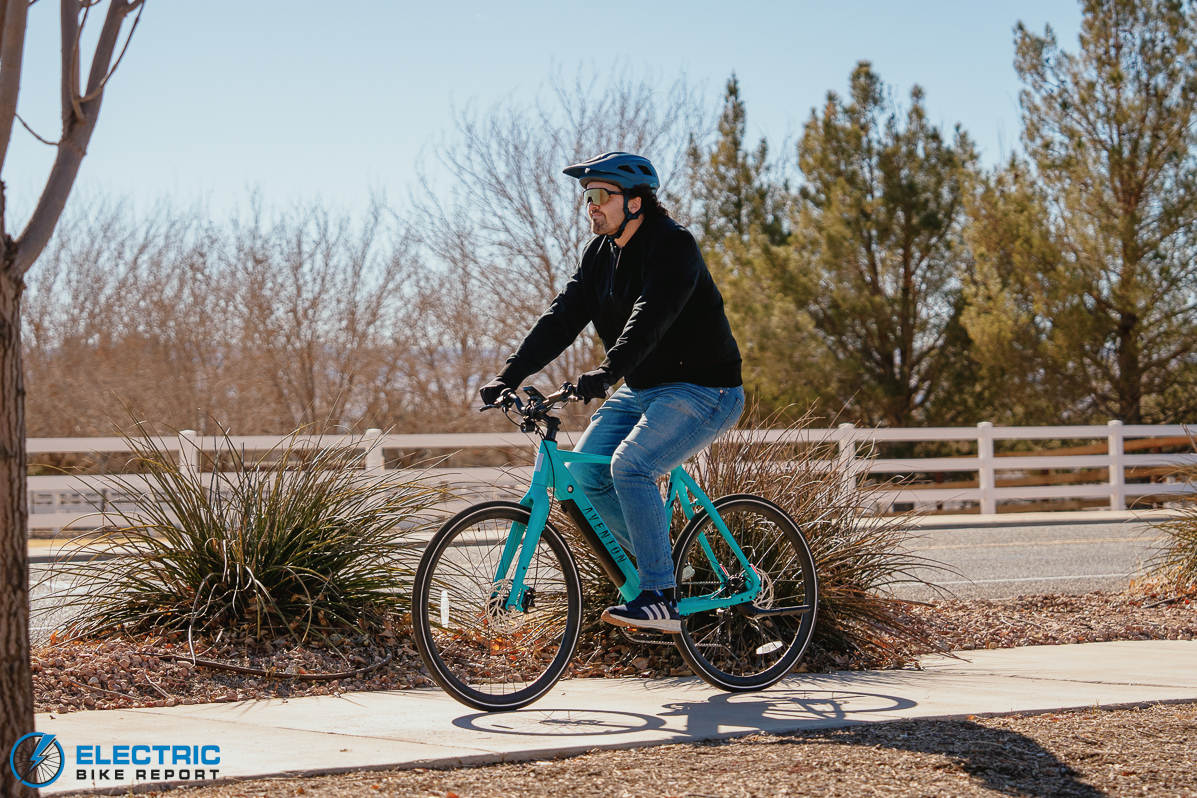
Notice how upright the posture is. It’s more relaxed than your average city/urban e-bike.
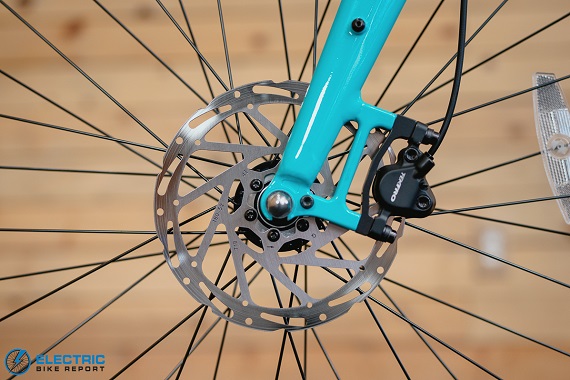
Hydraulic brakes with 180mm rotors. Reliable stopping power every time they are used.
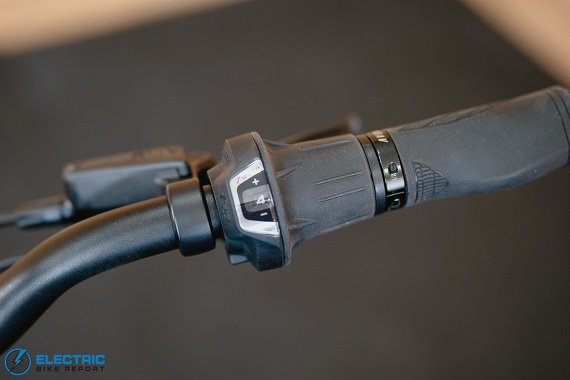
I like the satisfying click of the Revoshift. It’s nice to keep your fingers around the grip it all times too.
Aventon Soltera 2.5 Review: Brake Test

After testing the brakes, the Soltera 2.5 delivered a solid average braking distance of 22’4”. For context, the average for city-style e-bikes is around 23’8”, so this result puts the Soltera ahead of the pack.
One of the standout upgrades on this model is the Tektro hydraulic brakes. They perform reliably, offering good stopping power and overall value.
In the city/urban e-bike category, it’s common to see mechanical brakes and smaller 160mm rotors due to the lighter weight of these bikes. While we don’t typically fault other brands for going that route, the inclusion of hydraulic brakes with 180mm rotors on the Soltera feels like a meaningful value add. It’s a thoughtful upgrade that enhances performance while staying true to the bike’s lightweight design.
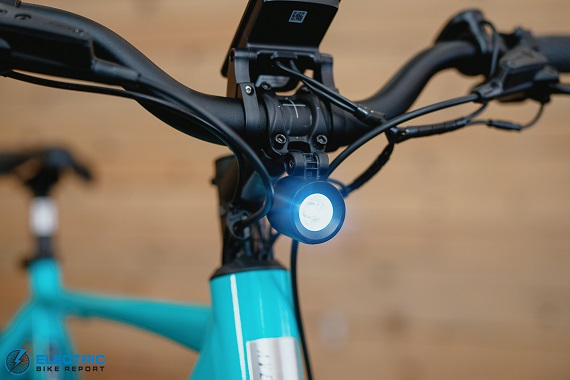
The Soltera 2.5 includes a headlight for riding at dusk and keeping visible.
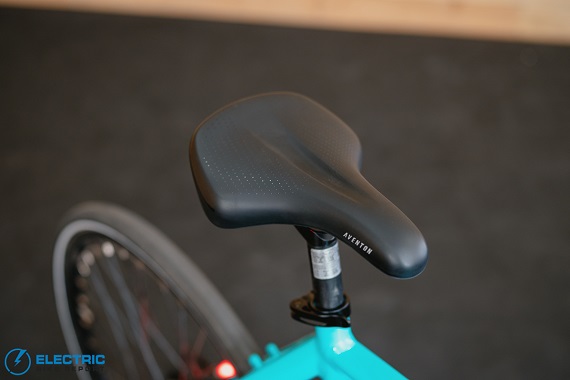
Aventon’s saddle is comfortable and supportive.
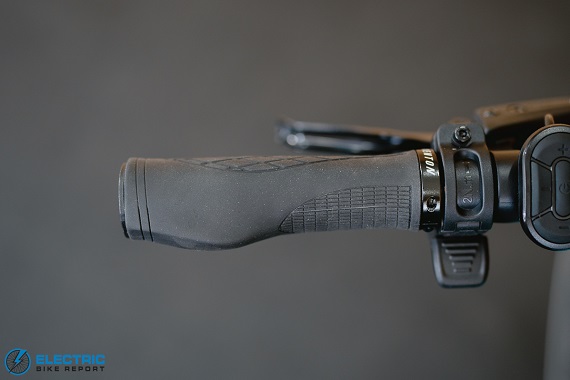
The lock-on rubber grips have a nice ergonomic shape.
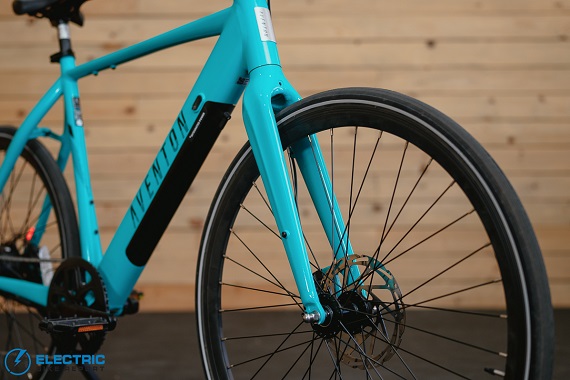
The rigid fork adds to the bike’s nice handling. It also has spots for adding fenders.
Aventon Soltera 2.5 Review: Ride Quality
The ride can best be described as agile. The narrow handlebars and 700x38c tires give the bike a precise feel, perfect for darting into alleys or taking corners at speed. The handlebars also feature a slight rise and a mild sweep, keeping your posture more upright and less strenuous. Purists might prefer a flat road bar, but I found this design fitting for a bike intended to appeal to a broader audience.
Aventon continues to impress with its sleek aesthetics. The clean frame lines, neatly managed cables, integrated taillights, and vibrant color display enhance both the look and functionality of the bike.
With three frame sizes available, most riders should find a proper fit. However, unlike previous iterations, the 2.5 doesn’t come in a mid-step frame, which might limit accessibility for shorter riders due to the 29” minimum standover height. Taller riders, on the other hand, will likely feel right at home. At 6’1”, I felt comfortable on the large test bike, and the shorter top tube, while unexpected, didn’t feel cramped—a pleasant surprise.
The Shimano Tourney derailleur is a standard entry-level choice, but the Revoshift shifter really stood out. Its satisfying click and ergonomic design allow you to shift gears while keeping your fingers securely wrapped around the grips.
Aventon ships the Soltera 2.5 at a highly competitive price point, but to fully maximize its commuter potential, you might want to consider adding some accessories. Fenders, racks, and a suspension seatpost are available at checkout, which will enable you to get even more out of your ride.
While it’s not a necessity to use on each ride, Aventon also includes an app that’s one of the nicer ones on the market. You can adjust speed, socialize with other Aventon owners, schedule maintenance, and push yourself by unlocking gamified medals as the app counts up your rides.
Aventon Soltera 2.5 Vs. Aventon Soltera 2: What are the Differences?
The main updates focus on the frame, brakes, and tires.
While the frame retains its familiar geometry, it’s now more reinforced, made from double-butted aluminum alloy instead of single-butted. Additionally, Aventon has introduced new cable routing through the headset, replacing the previous design where cables ran near the downtube and headtube junction on the 2.0. The result is a cleaner, more polished appearance.
The brakes have been upgraded from mechanical to hydraulic, offering improved stopping power. However, this change also comes with trade-offs. The new brake system no longer includes motor cutoff functionality, meaning the integrated taillights no longer double as brake lights. While I missed that feature, there is a silver lining—tapping the brake lever no longer disrupts your momentum, which anyone who’s accidentally braked mid-climb can appreciate.
The tires are still 700x38c in size, but the updated Kenda model features a road-style tread designed for faster rolling performance. On the road, the tires feel grippy and secure, delivering reliable traction despite their narrower profile.
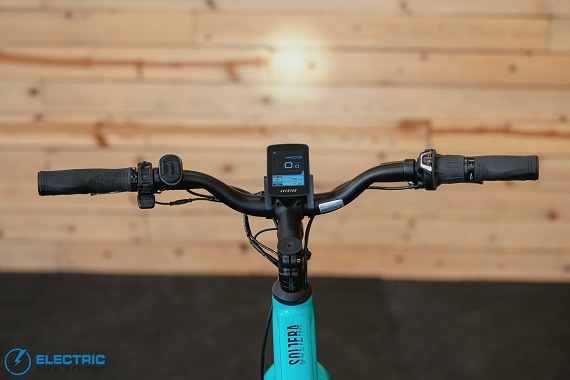
The 620mm bar keeps the handling crisp, but eh rise and slight sweep aide with the upright riding posture of the bike.
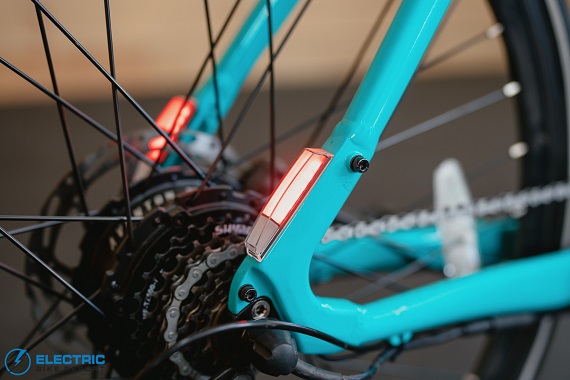
We always appreciate integrated rear lights and turn signals.
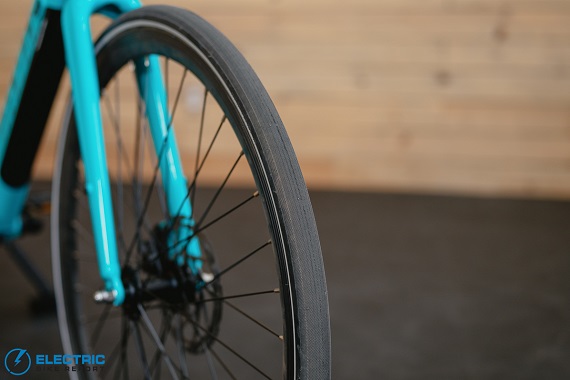
The narrow tire sticks to the roads well with a typical road tread pattern.
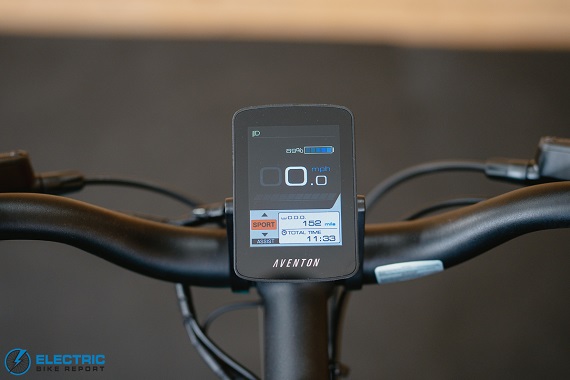
Aventon’s color display is one of the easier to see units, and it’s a little nicer than we usually find in this price tier.
Aventon Soltera 2.5 Review: Summary / Where to Buy
The motor provides smooth and natural engagement, empowering you to do more without feeling overpowered. It strikes the perfect balance, making your ride feel both capable and enjoyable.
The handling is another standout feature. It’s nimble and precise, as you’d expect from a city bike, but it’s also more forgiving and comfortable than most when it comes to body posture. The shorter top tube and the rise in the handlebar reduce strain on the rider, especially over longer distances. Combined with the impressive battery efficiency the Soltera demonstrated, this is a bike built for extended rides.
For anyone in search of an e-bike that’s easy to carry up a few flights of stairs and won’t break the bank, the Soltera 2.5 is an excellent choice. It has plenty to satisfy first-time city riders while offering seasoned cyclists the enhanced capabilities and enjoyable rides they’ll appreciate.
Happy Riding! Make sure to let us know if you have any questions or if you think we left anything out in this review of the Aventon Soltera 2.5 down in our comments section.



Nice bike, but when is the Aventure 3 coming out?
No word yet. The Aventure 2 is starting to get long in the tooth, so likely soonish, but not entirely sure! They won’t say anything when we ask 🙂
I am confused on your range analysis.
Bar chart
TESTER for Max PAS: Natasha Taylor | Weight: 160 lbs | Height: 6′-1″ Range 19.2 Miles
TESTER for Min PAS: Hadley Campbell | Weight: 120 lbs | Height: 5′-3″ Range 63.4 Miles
Under the Scatter plot
Max Power Range Test, we managed to cover 29.26 miles tester not specified
Min Power Range Test, using only Eco assist, we hit an impressive 55 miles.
Hey Jerome, thanks for pointing that out, and sorry for the confusion. Looks like we had a typo and leftover data from the bar chart template. It was 29.2 and 55 miles across the two tests.